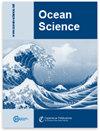Effects of sea level rise and tidal flat growth on tidal dynamics and geometry of the Elbe estuary
IF 4.1
3区 地球科学
Q2 METEOROLOGY & ATMOSPHERIC SCIENCES
引用次数: 0
Abstract
Abstract. Future global mean sea level rise (SLR) will affect coastlines and estuaries in the North Sea and therefore also coastal protection structures, unique local ecosystems and important waterways. SLR will not only raise water levels but also influence tidal dynamics and morphodynamics, which is why the tidal flats of the Wadden Sea can grow to a certain extent with SLR. Investigations on the effects of climate-change-induced SLR and the related potential bathymetric changes inside of estuaries form an important basis for identifying vulnerabilities and developing appropriate adaptation strategies. To analyse the influence of potential SLR and tidal flat elevation scenarios on the tidal dynamics in the Elbe estuary, we used a highly resolved hydrodynamic numerical model of the German Bight. The analysis results show increasing tidal range in the Elbe estuary solely due to SLR. They also reveal strongly varying changes with different tidal flat growth scenarios: while tidal flat elevation up to the mouth of the estuary can cause tidal range to decrease relative to SLR alone, tidal flat elevation in the entire estuary can lead to an increase in tidal range relative to SLR alone. Further analyses show how the geometric parameters of the Elbe estuary are changing due to SLR and tidal flat elevation. We discuss how these changes in estuarine geometry can provide an explanation for the changes in tidal range.海平面上升和滩涂增长对易北河口潮汐动力学和几何形状的影响
摘要。未来全球平均海平面上升(SLR)将影响北海的海岸线和河口,从而影响海岸保护结构、当地独特的生态系统和重要水道。SLR 不仅会提高水位,还会影响潮汐动力学和形态动力学,这就是为什么瓦登海的滩涂会在一定程度上随着 SLR 而扩大的原因。对气候变化引起的可持续土地退化和干旱的影响以及河口内相关的潜在水深变化进行调查,是确定脆弱性和制定适当适应战略的重要依据。为了分析潜在的可持续土地退化和潮平面抬升情景对易北河口潮汐动力学的影响,我们使用了一个高分辨率的德国湾水动力数值模型。分析结果表明,易北河口的潮差增大完全是可持续土地退化造成的。分析结果还显示,不同的潮滩增高方案会产生强烈的变化:相对于可持续土地退化,河口潮滩增高会导致潮差减小,而相对于可持续土地退化,整个河口的潮滩增高会导致潮差增大。进一步的分析表明,易北河河口的几何参数是如何因 SLR 和潮位抬升而发生变化的。我们将讨论这些河口几何参数的变化如何解释潮差的变化。
本文章由计算机程序翻译,如有差异,请以英文原文为准。
求助全文
约1分钟内获得全文
求助全文
来源期刊

Ocean Science
地学-海洋学
CiteScore
5.90
自引率
6.20%
发文量
78
审稿时长
6-12 weeks
期刊介绍:
Ocean Science (OS) is a not-for-profit international open-access scientific journal dedicated to the publication and discussion of research articles, short communications, and review papers on all aspects of ocean science: experimental, theoretical, and laboratory. The primary objective is to publish a very high-quality scientific journal with free Internet-based access for researchers and other interested people throughout the world.
Electronic submission of articles is used to keep publication costs to a minimum. The costs will be covered by a moderate per-page charge paid by the authors. The peer-review process also makes use of the Internet. It includes an 8-week online discussion period with the original submitted manuscript and all comments. If accepted, the final revised paper will be published online.
Ocean Science covers the following fields: ocean physics (i.e. ocean structure, circulation, tides, and internal waves); ocean chemistry; biological oceanography; air–sea interactions; ocean models – physical, chemical, biological, and biochemical; coastal and shelf edge processes; paleooceanography.
 求助内容:
求助内容: 应助结果提醒方式:
应助结果提醒方式:


